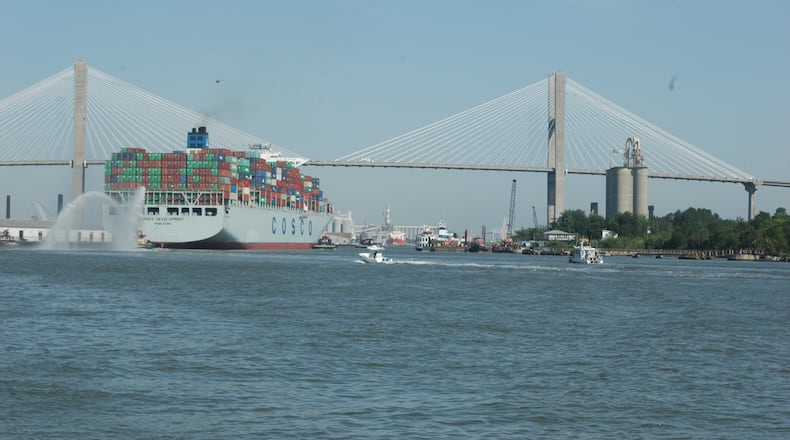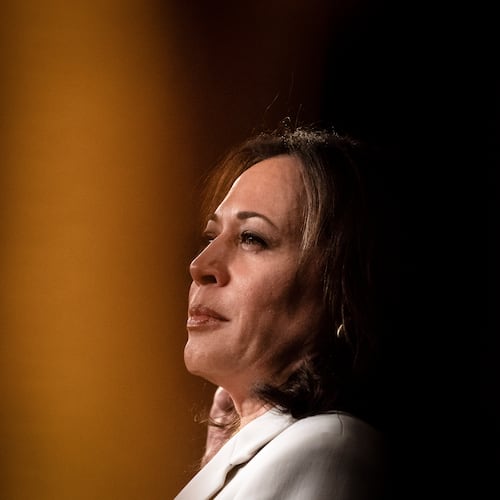Just before I pointed the pick-up down I-75 to come here for a taping of GPB’s “Political Rewind,” I received a small cache of documents from the state Department of Transportation that addressed how the Eugene Talmadge Memorial Bridge came to bear the name of a Georgia governor who was a fierce defender of white supremacy and segregation.
Last month, I told you of state Rep. Ron Stephens' effort to put the name of Juliette Gordon Low, founder of the Girl Scouts, on the eye-catching suspension bridge.
Stephens contends that the Talmadge name applied only to a previous structure built in 1953. The replacement bridge, built in 1991, has no name, the lawmaker argues.
Among the DOT documents handed to me was a letter of reply to Stephens and state Sen. Lester Jackson, D-Savannah. The lawmakers had asked the DOT whether their measure to put Low’s name on the bridge, introduced this week by Stephens, conflicted with other naming resolutions approved by the Legislature or the state DOT board.
The letter from Russell McMurray, the DOT commissioner, includes this sentence:
"We have found that there is one conflict with this dedication. This bridge has been dedicated as the Eugene Talmadge Memorial Bridge."
But on whose authority?
Which brings us to the second document handed over by the DOT – a 1991 state House resolution that clearly indicates that machinations were afoot to make sure the new Savannah River bridge wouldn’t bear Talmadge’s name:
Whereas, certain proposals have been made with respect to renaming this bridge; and
Whereas, it is the sense of this body that this bridge should not be renamed but should rather continue to be known as the Eugene Talmadge Memorial Bridge.
Now, therefore be it resolved by the House of Representatives that this body hereby expresses its support for the continuation of the name "Eugene Talmadge Memorial Bridge" and hereby memorializes its sentiment that the name of said bridge should not be changed.
The last lines of the resolution ask that Georgia’s congressional delegation and the state DOT board be informed of the above. But there was no attempt to have the state Senate endorse the resolution as well – which is a huge signal that there was opposition in that chamber.
Which brings me to last night's taping of GPB's "Political Rewind" here in Savannah. Bill Nigut, the host, was there, as was Eric Johnson, the former state senator and GOP candidate for governor.
Sitting next to Johnson was Al Scott, the chairman of the Chatham County Commission, who served in the state Senate until 1991, when he was appointed state labor commissioner by Gov. Zell Miller.
You can listen to “Rewind” at 2 p.m. today. Scott filled an important gap in the story of the Talmadge bridge:
"Tom Coleman, who was chair of the transportation committee in the Senate, wanted the bridge named the Savannah River Bridge," Scott said. [House Speaker] Tom Murphy was the person insisting that the Talmadge name remain on the bridge. And I think that's why you saw a single-chamber resolution."
Coleman was from Savannah.
In the 1990s, it was the DOT board that had the power to place names on roads and bridges in Georgia. Only several years later was that authority transferred to the Legislature.
So I asked Natalie Dale, spokeswoman for the state DOT, to explain her agency’s contention that the Gene Talmadge bridge indeed remains the Gene Talmadge bridge.
She pointed me to the final document that the DOT had handed me – the resolution passed 62 years ago by what was then the State Highway Board of Georgia. Because the 1991 bridge carries the same road into South Carolina now that it did in 1953, no renewal of the Talmadge name was necessary, Dale said.
Here’s the tidbit that’s interesting. The resolution that added Gene Talmadge’s name to the bridge was passed on June 15, 1956. The date is important.
Marvin Griffin was governor, and segregation was under attack. President Dwight Eisenhower’s decision to send troops into Little Rock, Ark., to enforce school integration was on the horizon, only a year away.
On Feb. 6, 1956, in an address to a joint session of the Georgia Legislature, Griffin demanded a doctrine of “massive resistance” to federal efforts to end white supremacy in the South.
One result: The Legislature added the Confederate battle emblem to the state flag.
Four months after Griffin ordered up a doctrine of no compromise on segregation, the state highway board added the name of Eugene Talmadge, a fierce defender of segregation and the whites-only primary, to a bridge that served as the welcome mat that greeted coastal visitors from the north.
In other words, the Talmadge Bridge may have been a two-fer: A memorial to a deceased Georgia governor, and a middle finger aimed at Washington.
I’ve attached the documents below:
About the Author
The Latest
Featured



